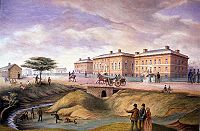| Double Shuffle | |
|---|---|
 | |
| Event | Political episode in the Province of Canada in 1858 |
| Cause | Defeat of the Macdonald–Cartier government |
| Date | July 29, 1858 |
| Replacement | Brown–Dorion government installed and then fell |
| Date | August 2 to 5, 1858 |
| Outcome | Cartier–Macdonald government formed |
| Date | August 6 and 7, 1858 |
The double shuffle of August 1858 is the kind of event that persuades historians not to write about nineteenth-century politics. It depends on such an accumulation of period detail and constitutional arcana that making it plausible is like trying to explain the notwithstanding clause to a visiting Martian.
The Double Shuffle was a political episode in the Province of Canada in 1858. It began on July 28, 1858, when the coalition government of John A. Macdonald (Liberal-Conservative) and George-Étienne Cartier (Bleu) was defeated on a confidence vote in the Legislative Assembly of the Province of Canada, concerning the location of the seat of government for the Province. The government resigned the next day.
The two opposition leaders, George Brown (Reform) and Antoine-Aimé Dorion (Rouge), formed a new government. However, Macdonald and Cartier were able to defeat the Brown–Dorion government in the Assembly on August 2, 1858. One factor contributing to that defeat was a statutory requirement that new Cabinet members automatically lost their seats on appointment, and had to stand for re-election in ministerial by-elections. Brown, Dorion, and the rest of their new Cabinet therefore immediately lost their seats in the Assembly. Those vacancies helped shift the balance of power in the Assembly in favour of Cartier and Macdonald.
Cartier and Macdonald were then able to form a new government, with the support of an influential independent member of the Assembly, Alexander Tilloch Galt. They took advantage of an exception in the statute which provided that a Cabinet minister who was appointed to a different position in Cabinet did not have to resign and seek re-election.[2] Cartier and Macdonald appointed most of the members of their former Cabinet, including themselves, to different positions in their new Cabinet. The next day, they re-appointed some of them back to their old positions. For example, Macdonald had been Attorney General for Canada West in their previous Cabinet. For one day, he was the Postmaster General in their new Cabinet. The next day, he was again the Attorney General for Canada West. This "Double Shuffle" of the Cabinet was upheld by the courts.
The double shuffle had the immediate effect of keeping Macdonald and Cartier in power, even though their previous government had been defeated on a confidence measure just a week earlier. It also fuelled a strong personal animosity between Macdonald and Brown, who were already bitter political rivals. More long term, by highlighting the political instability of the Province of Canada, the Double Shuffle contributed to the Great Coalition of Macdonald, Cartier, Galt and Brown in 1864, formed for the purpose of seeking Canadian Confederation and ending the political deadlock in the Province of Canada.
- ^ Christopher Moore, 1867 — How the Fathers Made a Deal (Toronto: McClelland & Stewart, 1997), pp. 18–19.
- ^ ""Double Shuffle" manoeuvre (1858)". Dictionary of Canadian Biography. Retrieved July 27, 2024.